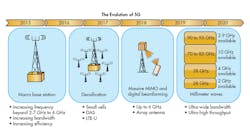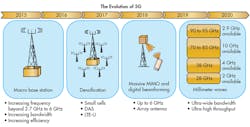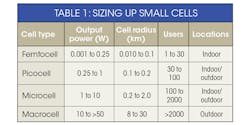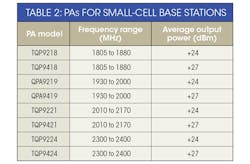Small Cells Help Keep 5G Connected
This file type includes high-resolution graphics and schematics when applicable.
As more users tap into wireless-communications services, the demand on wireless network capacity intensifies in both indoor and outdoor locations. Such network density or densification further pressures wireless carriers to keep pace with the increased consumption of frequency bandwidth via voice, video, and data. It also drives those carriers to expand their cellular/wireless infrastructure with minimum increases in cost or disruption of service to wireless customers. Thus, many are turning to small cells as a solution.
The rollout of fifth-generation (5G) wireless networks will address demands for increased capacity and data, but these networks are still some years away. So, a more practical answer that’s in keeping with today’s fourth-generation (4G) wireless networks is to use small cells, which function as miniature base stations that are added to an existing wireless network. They operate at relatively low power levels to fill any “holes” that exist in wireless coverage, in both indoor and outdoor locations.
As an example of the magnitude of growing wireless user demands, fans attending the National Football League’s (NFL) 2016 Super Bowl championship game in Santa Clara, Calif., used more than 7 TB of data on the Verizon Wireless network alone—nearly three times as much data used at the 2015 Super Bowl game. Fans connected to the network via smartphones and many other unique wireless devices. They benefited from the generous capacity provided by 4G Long Term Evolution (LTE) technology bolstered by the use of small cells, macrocells, and mobile cell sites (as reported by Verizon Wireless in a press release dated February 8, 2016).
Small Cells + DAS Solutions
Small cells and distributed antenna systems (DAS) are being employed (Fig. 1) to achieve increased data capacity in 5G wireless networks while enhancing quality of service (QoS) in those networks. But with densification comes interference and mobility handover challenges between small cells and the macro network, requiring careful network design and management.
As mobile communications devices move from a macrocell environment to a small-cell coverage area, the network will instantaneously switch profiles. The relatively low power levels of small cells allow mobile devices to be in close proximity to those small cells. They are able to gain network access while conserving battery life, and they needn’t establish radio communications links with more distant larger cell sites at transmission levels diminished by distance. Mobile-device users will benefit from increased data speeds, mobility, and flexibility, too, since small cells and DAS solutions support multiple standards, such as third-generation (3G) and 4G cellular, and implement carrier aggregation with LTE Advanced (LTE-A) systems.
Antenna technologies such as multiple-user multiple-input, multiple-output (MIMO) approaches, beam steering, and phased-array techniques help provide additional wireless coverage and interoperability of multiple-band 3G and 4G systems. With massive MIMO methods, wireless network operators can increase data rates and network capacity by transmitting multiple, spatially separated data streams over the same frequency band, using multiple antennas on the base station and the user’s device.
Massive MIMO base stations seek to provide from 16 to 256 channels, challenging designers of those base stations to target smaller component sizes with high energy efficiency and effective thermal management. Therefore, highly power-efficient semiconductor technologies become attractive for such base stations.
High levels of semiconductor integration are also instrumental in achieving the high channel counts in these relatively small-sized base stations. Squeezing as many as 256 transmit channels into a single base station requires subsystems that package power amplifiers (PAs), low-noise amplifiers (LNAs), and switches into compact modules, and employing small-form-factor filter solutions.
Technology Potpourri
As Table 1 shows, small cells differ in output power levels, coverage areas, and number of users served. For the best performance and power efficiency, the subsystems used in small-cell base stations must combine components based on different process technologies. For example, PAs may provide suitable output power and power efficiency.
Filters could require yet a third technology, especially for operating conditions that may experience extremes of temperature and humidity. Temperature-stable bulk-acoustic-wave (BAW) LowDrift filters from Qorvo provide a solution for filtering high-power signals while also avoiding interference from adjacent frequency bands.
In addition to the various components required for wireless infrastructure designs, including filters, switches, and LNAs, Qorvo developed a line of highly integrated PAs for small-cell base stations. The PAs do not require linearization, and feature on-chip bias control and temperature-compensation circuitry to further simplify the design of a small-cell base station. They are available with +24- or +27-dBm average linear output power when driving a 20-MHz-wide LTE signal (Table 2). The PAs also incorporate two stages of amplifier gain in low-cost surface-mount-technology (SMT) packages.
For example, model TQP9218 is a 0.25-W (+24-dBm) PA designed for small-cell base stations operating from 1805 to 1880 MHz. It offers 31-dB small-signal gain across its frequency range with internal impedance matching, on-chip bias control circuitry, and temperature-compensation circuitry—all packed into a 7- × 7-mm RoHS-compliant SMT housing (Fig. 2). The PA achieves 16% power-added efficiency (PAE) and draws just 240-mA quiescent current from a +4.5-V dc supply.
Simply put, better wireless network coverage is needed to support the demand for more voice, video, and data among the growing number of wireless-communzications users. Solutions for enhanced coverage include DAS and the addition of small-cell base stations to larger macro-cells. As technologies like automated vehicle control and safety along with literally millions of Internet of Things (IoT) devices flood wireless operating bands, the need for small-cell base stations will only increase in the years to come.
Tuan Nguyen is Product Line Director of Wireless Infrastructure for Qorvo.
Qorvo Inc. (TriQuint), 2300 NE Brookwood Parkway, Hillsboro, OR 97124; (844) 890-8163
Looking for parts? Go to SourceESB.





